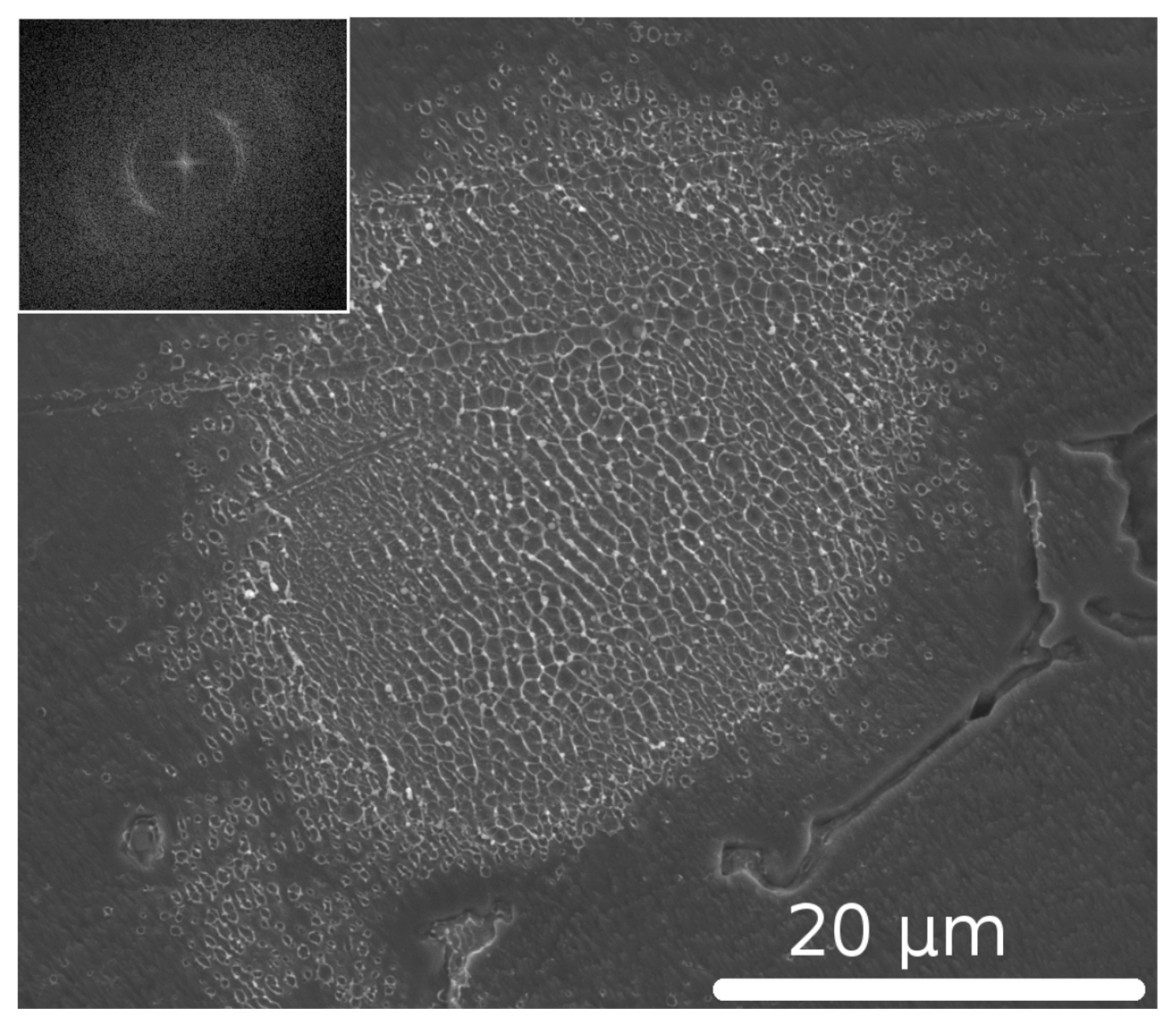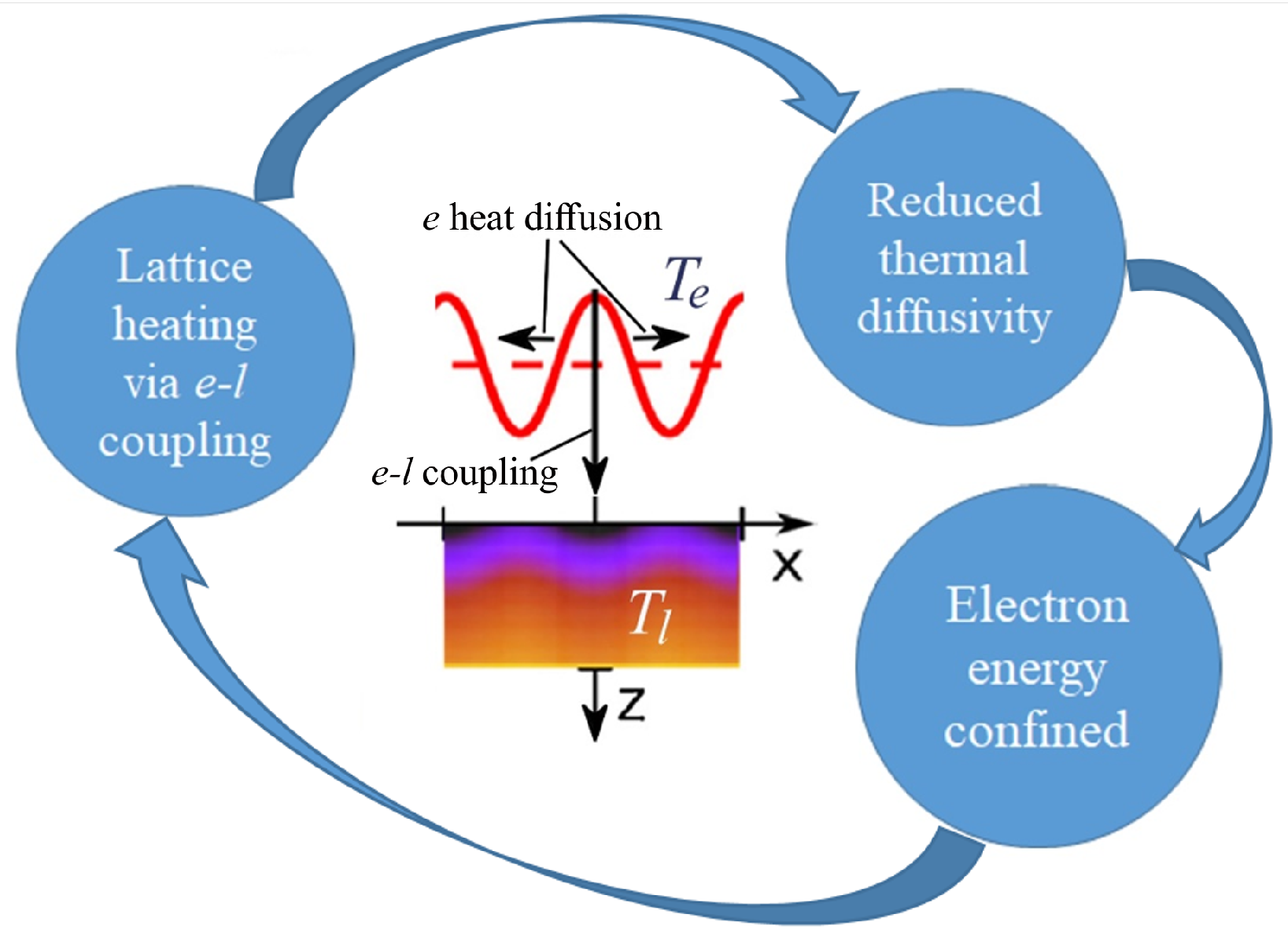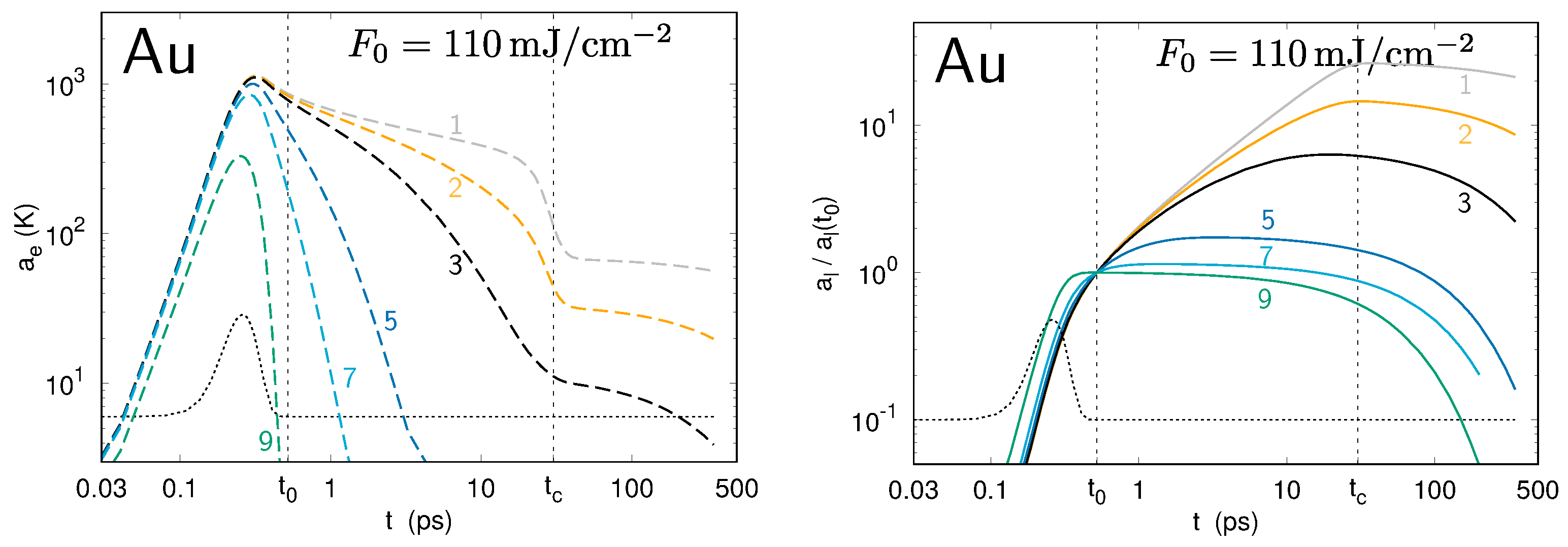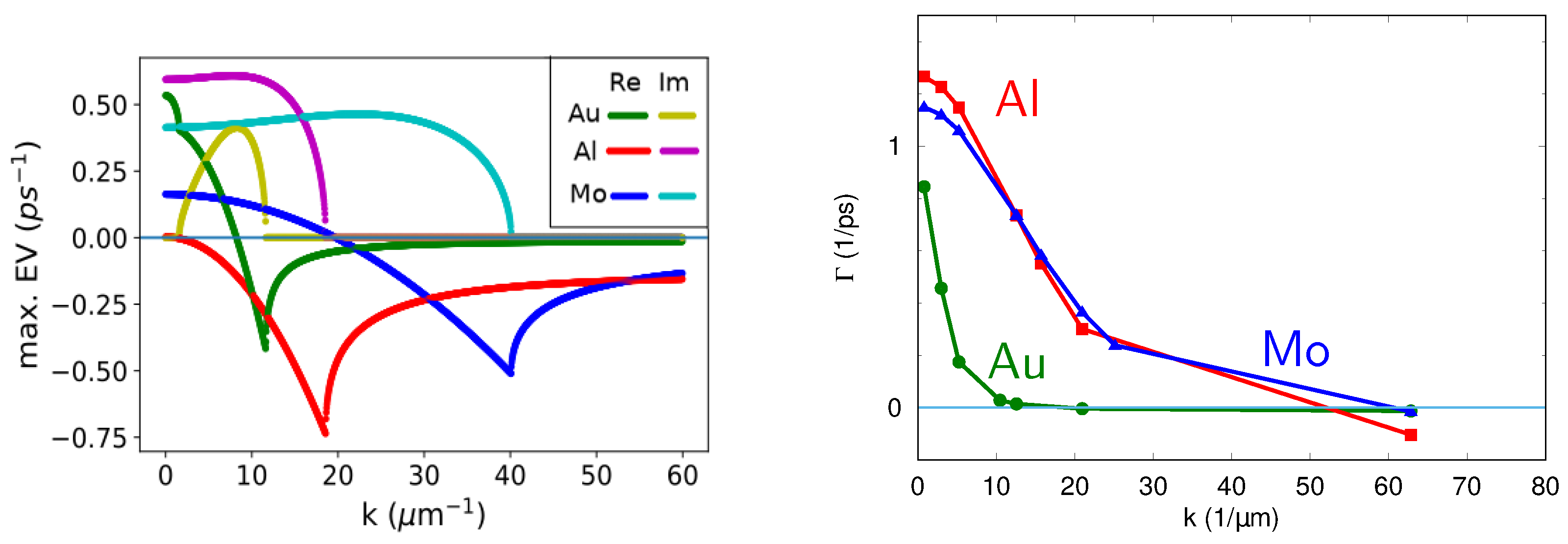Three-Step Description of Single-Pulse Formation of Laser-Induced Periodic Surface Structures on Metals
Abstract
1. Introduction
2. Experimental Observation
3. Thermal Steps: Temperature Modulations along the Surface
3.1. Step 1: Modulation of the Electron Temperature
- a nearly ideal case of monochromatic light with an angle of incidence corresponding to the surface plasmon excitation, which illuminates a nearly-ideal grating instead of a rough surface;
- a situation closer to laser ablation experiments, in which the light is monochromatic and where the surface satisfies the conditions for plasmon excitation but its roughness spectrum is broad; and
- a situation even closer to laser ablation experiment, in which spectrally-broad femtosecond laser pulses with varying incidence angle impinge on a nearly-ideal grating.
- The surface plasmon excitation on a high-quality metallic grating was first discovered by Robert Wood [21,23] in 1902, who observed a narrow dark line in the spectrum of a broad-band light source. According to his results, the intensity dropped by the factor of ten over a spectral range narrower than the distance between the sodium lines, i.e., within the spectral range nm. This means that, under the conditions of surface plasmon resonance, at least 90% of the incident light excites collective oscillations of the electrons at the surface.
- Excitation of plasmons on gold ridges of rectangular profile positioned on a gold film was studied in [28]. Gratings with a different number of ridges were illuminated at normal incidence to the film surface by continuous monochromatic laser sources within a certain range of wavelengths. The maximum efficiency of plasmon excitation of 20% was demonstrated. Reducing the number of ridges to one decreased the plasmon excitation efficiency approximately by the factor of ten (down to 2–3%). We note that the single ridge case can be considered as a demonstration of a reduced plasmon excitation efficiency on a randomly rough surface.
- Experimental results on plasmon excitation on metal grating with femtosecond laser pulses at different angles of incidence were recently published by Miyaji et al. [29,30], who found that plasmons can be excited with broadband femtosecond laser pulses similar to ones used in our experiments. However, the best excitation efficiency of approximately 10% was measured only in a narrow range of angles of incidence approximately 25°. For incidence angles smaller than 20°, no excitation of plasmons was observed.
3.2. Step 2: Lattice Temperature
- Trace of the matrix
- Determinant of the matrix
3.3. Numerical Modeling
3.4. On the Evolution of the Lattice Temperature Modulations
4. Relocation Step: Hydrodynamic Instabilities
4.1. Criteria of Hydrodynamic Instabilities Development
- Hydrodynamic instabilities manifest themselves in a reorganization of the molten material on the surface. These processes start if any kind of driving force for such a reorganization overbalances the friction forces. The ratio between the driving and friction terms in the Navier–Stokes equation can be represented as characteristic numbers serving as the criteria to assess whether a certain type of instability can develop or not. For example, the Marangoni number characterizes the importance of the forces related to the surface tension, while the Rayleigh number evaluates the possible contribution of the inertial forces. These numbers can be calculated for a given set of parameters such as the depth of the molten layer d, surface tension and its temperature derivative , difference between the melt temperature at the top and at the bottom of the laser-molten layer , acceleration of the surface , thermal diffusivity D, volumetric thermal expansion coefficient , dynamic viscosity , and some others. The analysis of the characteristic numbers allows a fast and easy conclusion about the roles of different mechanisms upon the LIPSS formation as it was systematically shown for fused silica [7]. If a characteristic number exceeds some critical value, the corresponding instability can develop.The disadvantage of this simplified approach is in the assumption that the above-mentioned parameters are constants or slowly changing in space and time. If this assumption is not valid, a more complex analysis is required (for details see, e.g., in [45]). The advantage is that it renders unnecessary the solution of the Navier–Stokes equations, which are extremely hard to solve [46].
- Hydrodynamic instabilities can develop in a certain range of spatial periods where each period has a positive growth rate. The maximal corresponds to the so-called fastest growing mode (fgm). The period of the fastest growing mode defines the observed period resulting from the instability if it has enough time to develop. The latter may not always be the case due to rapid solidification after the laser pulse. Moreover, the linear theory of the instabilities is formally valid only for small amplitudes of the surface profiles. In the other words, it is difficult to make a universal statement about the relation of the LIPSS period to .When an instability starts to develop, the amplitudes of the different spectral components of the surface profile depend on time t as . Here, and is the initial spectrum of the amplitudes, which is established by, e.g., the SSW as discussed in the previous sections. The spatial mode k corresponding to the maximum of the can change in time: if , the exponential factor can be neglected and the observed spectrum of the LIPSS will be close to the initial spectrum of SSW, . If the instability has more time to develop before the resolidification occurs, the period of the LIPSS will be closer to the fastest growing mode because the exponent will dominate in this case. This consideration explains the experimentally observed wavelength dependence of picosecond LIPSS on copper [18].
4.2. Analysis of the Instabilities
5. Discussion
- the periodic modulation of the electron temperature is assumed from the coupling of the incident laser pulse with the surface roughness;
- the periodic modulation of the lattice temperature is induced by the relaxation between electrons and phonons; and
- the formation of the surface profile is due to melt relocation, which is induced by the hydrodynamic instabilities in the thin melt layer, influenced by the temperature modulation.
Author Contributions
Funding
Conflicts of Interest
Abbreviations
| DLIP | direct laser interference patterning |
| FFT | fast Fourier transform (algorithm) |
| fgm | fastest growing mode |
| LIPSS | laser-induced periodic surface structures |
| LSFL | Low Spatial Frequency LIPSS |
| SSW | surface-scattered wave |
| TSM | three-step model |
Appendix A
References
- Birnbaum, M. Semiconductor Surface Damage Produced by Ruby Lasers. J. Appl. Phys. 1965, 36, 3688. [Google Scholar] [CrossRef]
- Rebollar, E.; Pérez, S.; Hernández, J.J.; Martín-Fabiani, I.; Rueda, D.R.; Ezquerra, T.A.; Castillejo, M. Assessment and Formation Mechanism of Laser-Induced Periodic Surface Structures on Polymer Spin-Coated Films in Real and Reciprocal Space. Langmuir 2011, 27, 5596–5606. [Google Scholar] [CrossRef]
- Beltaos, A.; Kovačević, A.G.; Matković, A.; Ralević, U.; Savić-Šević, S.; Jovanović, D.; Jelenković, B.M.; Gajić, R. Femtosecond laser induced periodic surface structures on multi-layer graphene. J. Appl. Phys. 2014, 116, 204306. [Google Scholar] [CrossRef]
- Kasischke, M.; Maragkaki, S.; Volz, S.; Ostendorf, A.; Gurevich, E.L. Simultaneous nanopatterning and reduction of graphene oxide by femtosecond laser pulses. Appl. Surf. Sci. 2018, 445, 197–203. [Google Scholar] [CrossRef]
- Costache, F.; Henyk, M.; Reif, J. Modification of dielectric surfaces with ultra-short laser pulses. Appl. Surf. Sci. 2002, 186, 352–357. [Google Scholar] [CrossRef]
- Varlamova, O.; Costache, F.; Reif, J.; Bestehorn, M. Self-organized pattern formation upon femtosecond laser ablation by circularly polarized light. Appl. Surf. Sci. 2006, 252, 4702. [Google Scholar] [CrossRef]
- Gräf, S.; Kunz, C.; Engel, S.; Derrien, T.; Müller, F. Femtosecond Laser-Induced Periodic Surface Structures on Fused Silica: The Impact of the Initial Substrate Temperature. Materials 2018, 11, 1340. [Google Scholar] [CrossRef]
- Emmony, D.C.; Howson, R.P.; Willis, L.J. Laser mirror damage in germanium at 10.6 μm. Appl. Phys. Lett. 1973, 23, 598–600. [Google Scholar] [CrossRef]
- Sipe, J.E.; Young, J.F.; Preston, J.S.; van Driel, H.M. Laser-induced periodic surface structure. I. Theory. Phys. Rev. B 1983, 27, 1141–1154. [Google Scholar] [CrossRef]
- Akhmanov, S.A.; Emel’yanov, V.I.; Koroteev, N.I.; Seminogov, V.N. Interaction of powerful laser radiation with the surfaces of semiconductors and metals: Nonlinear optical effects and nonlinear optical diagnostics. Sov. Phys. Uspekhi 1985, 28, 1084–1124. [Google Scholar] [CrossRef]
- Bonse, J.; Rosenfeld, A.; Krüger, J. On the role of surface plasmon polaritons in the formation of laser-induced periodic surface structures upon irradiation of silicon by femtosecond-laser pulses. J. Appl. Phys. 2009, 106, 104910. [Google Scholar] [CrossRef]
- Gurevich, E.L. Mechanisms of femtosecond LIPSS formation induced by periodic surface temperature modulation. Appl. Surf. Sci. 2016, 374, 56–60. [Google Scholar] [CrossRef]
- Gedvilas, M.; Voisiat, B.; Račiukaitis, G.; Regelskis, K. Self-organization of thin metal films by irradiation with nanosecond laser pulses. Appl. Surf. Sci. 2009, 255, 9826–9829. [Google Scholar] [CrossRef]
- Colombier, J.P.; Garrelie, F.; Brunet, P.; Bruyère, A.; Pigeon, F.; Stoian, R.; Parriaux, O. Plasmonic and Hydrodynamic Effects in Ultrafast Laser-Induced Periodic Surface Structures on Metals. JLMN-J. Laser Micro/Nanoeng. 2012, 7, 362–368. [Google Scholar] [CrossRef]
- Shih, C.Y.; Wu, C.; Shugaev, M.V.; Zhigilei, L.V. Atomistic modeling of nanoparticle generation in short pulse laser ablation of thin metal films in water. J. Colloid Interfaces Sci. 2017, 489, 3–17. [Google Scholar] [CrossRef]
- Levy, Y.; Derrien, T.J.Y.; Bulgakova, N.M.; Gurevich, E.L.; Mocek, T. Relaxation dynamics of femtosecond-laser-induced temperature modulation on the surfaces of metals and semiconductors. Appl. Surf. Sci. 2016, 374, 157–164. [Google Scholar] [CrossRef]
- Gurevich, E.L.; Levy, Y.; Gurevich, S.V.; Bulgakova, N.M. Role of the temperature dynamics in formation of nanopatterns upon single femtosecond laser pulses on gold. Phys. Rev. B 2017, 95, 054305. [Google Scholar] [CrossRef]
- Maragkaki, S.; Derrien, T.J.Y.; Levy, Y.; Bulgakova, N.M.; Ostendorf, A.; Gurevich, E.L. Wavelength dependence of picosecond laser-induced periodic surface structures on copper. Appl. Surf. Sci. 2017, 417, 88–92. [Google Scholar] [CrossRef]
- Bulgakova, N.; Stoian, R.; Rosenfeld, A. Laser-induced modification of transparent crystals and glasses. Quantum Electron. 2010, 40, 966. [Google Scholar] [CrossRef]
- Derrien, T.J.Y.; Krüger, J.; Itina, T.E.; Höhm, S.; Rosenfeld, A.; Bonse, J. Rippled area formed by surface plasmon polaritons upon femtosecond laser double-pulse irradiation of silicon: The role of carrier generation and relaxation processes. Appl. Phys. A 2014, 117, 77–81. [Google Scholar] [CrossRef]
- Wood, R.W. On a Remarkable Case of Uneven Distribution of Light in a Diffraction Grating Spectrum. Proc. Phys. Soc. Lond. 1902, 18, 269–275. [Google Scholar] [CrossRef]
- Lord Rayleigh, O.M.P.R.S., III. Note on the remarkable case of diffraction spectra described by Prof. Wood. Lond. Edinb. Dublin Philos. Mag. J. Sci. 1907, 14, 60–65. [Google Scholar] [CrossRef]
- Fano, U. The Theory of Anomalous Diffraction Gratings and of Quasi-Stationary Waves on Metallic Surfaces (Sommerfeld’s Waves). J. Opt. Soc. Am. 1941, 31, 213–222. [Google Scholar] [CrossRef]
- Gurevich, E.L.; Gurevich, S.V. Laser Induced Periodic Surface Structures induced by surface plasmons coupled via roughness. Appl. Surf. Sci. 2014, 302, 118–123. [Google Scholar] [CrossRef]
- Pavlov, D.V.; Gurbatov, S.O.; Kudryashov, S.I.; Gurevich, E.L.; Kuchmizhak, A.A. Laser-induced surface relief nanocrowns as a manifestation of nanoscale Rayleigh-Plateau hydrodynamic instability. Appl. Surf. Sci. 2020, 511, 145463. [Google Scholar] [CrossRef]
- Bonus, J.; Csákó, T.; Szörényi, T.; Szatmári, S. Ablation with femtosecond pulses: The effect of temporal contrast. Appl. Surf. Sci. 2007, 253, 7779–7782. [Google Scholar]
- Gnilitskyi, I.; Derrien, T.J.Y.; Levy, Y.; Bulgakova, N.M.; Mocek, T.; Orazi, L. High-speed manufacturing of highly regular femtosecond laser-induced periodic surface structures: Physical origin of regularity. Sci. Rep. 2017, 7, 8485. [Google Scholar] [CrossRef]
- Radko, I.P.; Bozhevolnyi, S.I.; Brucoli, G.; Martín-Moreno, L.; García-Vidal, F.J.; Boltasseva, A. Efficiency of local surface plasmon polariton excitation on ridges. Phys. Rev. B 2008, 78, 115115. [Google Scholar] [CrossRef]
- Miyaji, G.; Hagiya, M.; Miyazaki, K. Excitation of surface plasmon polaritons on silicon with an intense femtosecond laser pulse. Phys. Rev. B 2017, 96, 045122. [Google Scholar] [CrossRef]
- Miyaji, G.; Hagiya, M. Reduced damping of surface plasmon polaritons on silicon with intense femtosecond laser pulse. Jpn. J. Appl. Phys. 2019, 58, 050916. [Google Scholar] [CrossRef]
- Anisimov, S.I.; Luk’yanchuk, B.S. Selected problems of laser ablation theory. Sov. Phys. Uspekhi 2002, 45, 293–324. [Google Scholar] [CrossRef]
- Levy, Y.; Bulgakova, N.M.; Mocek, T. Laser-Induced Periodic Surface Structures Formation: Investigation of the Effect of Nonlinear Absorption of Laser Energy in Different Materials. Proc. SPIE 10228, Nonlinear Optics and Applications X, 102280T. [CrossRef]
- Wellershoff, S.S.; Hohlfeld, J.; Güdde, J.; Matthias, E. The role of electron-phonon coupling in femtosecond laser damage of metals. Appl. Phys. A 1999, 69, S99–S107. [Google Scholar]
- Lin, Z.; Zhigilei, L.V. Electron-Phonon Coupling and Electron Heat Capacity in Metals at High Electron Temperatures. Phys. Rev. B 2012, 77, 075133. [Google Scholar] [CrossRef]
- Bäuerle, D. Laser Processing and Chemistry; Springer: Berlin/Heidelberg, Germany, 2011. [Google Scholar]
- Rethfeld, B.; Kaiser, A.; Vicanek, M.; Simon, G. Ultrafast dynamics of nonequilibrium electrons in metals under femtosecond laser irradiation. Phys. Rev. B 2002, 65, 214303. [Google Scholar] [CrossRef]
- Palik, E.D. Handbook of Optical Constants of Solids; Academic Press: New York, NY, USA, 1985. [Google Scholar]
- Strogatz, S. Nonlinear Dynamics and Chaos: With Applications to Physics, Biology, Chemistry, and Engineering; Advanced Book Program; Westview Press: Boulder, CO, USA, 1994. [Google Scholar]
- Derrien, T.J.Y.; Sarnet, T.; Sentis, M.; Itina, T.E. Application of a two-temperature model for the investigation of the periodic structure formation on Si surface in femtosecond laser interaction. J. Optoelectr. Adv. Mater. 2010, 12, 610–615. [Google Scholar]
- Terekhin, P.; Benhayoun, O.; Weber, S.; Ivanov, D.; Garcia, M.; Rethfeld, B. Influence of surface plasmon polaritons on laser energy absorption and structuring of surfaces. Appl. Surf. Sci. 2020, 512, 144420. [Google Scholar] [CrossRef]
- Inogamov, N.A.; Zhakhovsky, V.V.; Petrov, Y.V.; Khokhlov, V.; Ashitkov, S.I.; Khishchenko, K.V.; Migdal, K.P.; Ilnitsky, D.K.; Emirov, Y.N.; Komarov, P.S.; et al. Electron-Ion Relaxation, Phase Transitions, and Surface Nano-Structuring Produced by Ultrashort Laser Pulses in Metals. Contrib. Plasma Phys. 2013, 53, 796–810. [Google Scholar] [CrossRef]
- Shugaev, M.V.; Gnilitskyi, I.; Bulgakova, N.M.; Zhigilei, L.V. Mechanism of single-pulse ablative generation of laser-induced periodic surface structures. Phys. Rev. B 2017, 96, 205429. [Google Scholar] [CrossRef]
- Sedao, X.; Saleh, A.A.; Rudenko, A.; Douillard, T.; Esnouf, C.; Reynaud, S.; Maurice, C.; Pigeon, F.; Garrelie, F.; Colombier, J.P. Self-Arranged Periodic Nanovoids by Ultrafast Laser-Induced Near-Field Enhancement. ACS Photonics 2018, 5, 1418–1426. [Google Scholar] [CrossRef]
- Abou-Saleh, A.; Karim, E.T.; Maurice, C.; Reynaud, S.; Pigeon, F.; Garrelie, F.; Zhigilei, L.V.; Colombier, J.P. Spallation-induced roughness promoting high spatial frequency nanostructure formation on Cr. Appl. Phys. A 2018, 124, 308–312. [Google Scholar] [CrossRef]
- Oron, A.; Davis, S.H.; Bankoff, S.G. Long-scale evolution of thin liquid films. Rev. Mod. Phys. 1997, 69, 931–980. [Google Scholar] [CrossRef]
- Fefferman, C.L. Existence and Smoothness of the Navier–Stokes Equation. In The Millennium Prize Problems; Clay Math. Inst.: Cambridge, MA, USA, 2006; pp. 57–67. [Google Scholar]
- Davis, S.H. Thermocapillary instabilities. Ann. Rev. Fluid Mech. 1987, 19, 403–435. [Google Scholar] [CrossRef]
- Rudenko, A.; Abou-Saleh, A.; Pigeon, F.; Mauclair, C.; Garrelie, F.; Stoian, R.; Colombier, J. High-frequency periodic patterns driven by non-radiative fields coupled with Marangoni convection instabilities on laser-excited metal surfaces. Acta Mater. 2020, 194, 93–105. [Google Scholar] [CrossRef]
- Pant, H.C.; Desai, T. Coherent structures in ablatively compressed ICF targets and Rayleigh-Taylor instability. Phys. Scr. 1996, T63, 158–161. [Google Scholar] [CrossRef]
- Hsing, W.W.; Hoffman, N.M. Measurement of Feedthrough and Instability Growth in Radiation-Driven Cylindrical Implosions. Phys. Rev. Lett. 1997, 78, 3876–3879. [Google Scholar] [CrossRef]
- Reif, J.; Varlamova, O.; Uhlig, S.; Varlamov, S.; Bestehorn, M. On the physics of self-organized nanostructure formation upon femtosecond laser ablation. Appl. Phys. A 2014, 117, 179–184. [Google Scholar] [CrossRef]







| Parameter | Units | Gold | Aluminum | Molybdenum |
|---|---|---|---|---|
| 71 [33] | 95.3 [34] (fit) | 350 [33] | ||
| 318 [33] | 237 [35] | 135 [33] | ||
| G | [33] | [36] | [33] | |
| [33] | [35] | [33] | ||
| 3.18 (1% of ) | 2.37 (1% of ) | 1.35 (1% of ) | ||
| 1337 [33] | 933 [35] | 2897 [33] | ||
| 12.4 [37] | 7.52 [37] | 19.0 [37] |
| Numbering | 1 | 2 | 3 | 4 | 5 | 6 | 7 | 8 | 9 |
|---|---|---|---|---|---|---|---|---|---|
| k (1/m) | 0.785 | 2.99 | 5.24 | 10.5 | 12.6 | 15.7 | 20.9 | 25.1 | 62.8 |
| (m) | 8.00 | 2.10 | 1.20 | 0.600 | 0.500 | 0.400 | 0.300 | 0.250 | 0.100 |
© 2020 by the authors. Licensee MDPI, Basel, Switzerland. This article is an open access article distributed under the terms and conditions of the Creative Commons Attribution (CC BY) license (http://creativecommons.org/licenses/by/4.0/).
Share and Cite
Gurevich, E.L.; Levy, Y.; Bulgakova, N.M. Three-Step Description of Single-Pulse Formation of Laser-Induced Periodic Surface Structures on Metals. Nanomaterials 2020, 10, 1836. https://doi.org/10.3390/nano10091836
Gurevich EL, Levy Y, Bulgakova NM. Three-Step Description of Single-Pulse Formation of Laser-Induced Periodic Surface Structures on Metals. Nanomaterials. 2020; 10(9):1836. https://doi.org/10.3390/nano10091836
Chicago/Turabian StyleGurevich, Evgeny L., Yoann Levy, and Nadezhda M. Bulgakova. 2020. "Three-Step Description of Single-Pulse Formation of Laser-Induced Periodic Surface Structures on Metals" Nanomaterials 10, no. 9: 1836. https://doi.org/10.3390/nano10091836
APA StyleGurevich, E. L., Levy, Y., & Bulgakova, N. M. (2020). Three-Step Description of Single-Pulse Formation of Laser-Induced Periodic Surface Structures on Metals. Nanomaterials, 10(9), 1836. https://doi.org/10.3390/nano10091836







